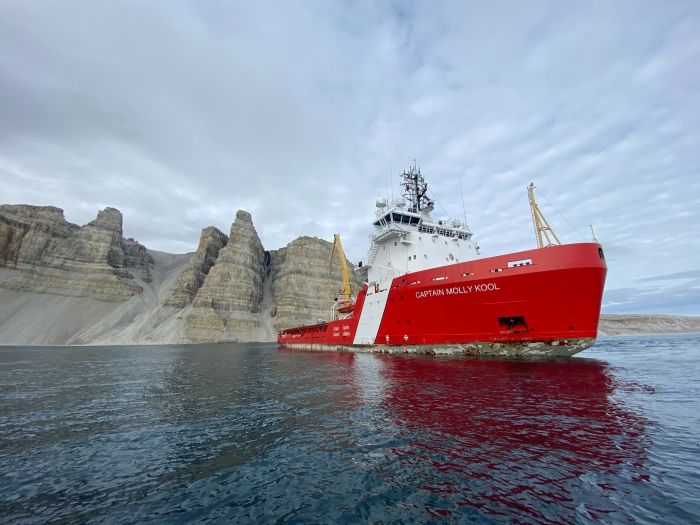Canadian Coast Guard Finishes Unique 2020 Arctic Operations Season

YELLOWKNIFE, NT: The Canadian Coast Guard completed its 2020 Arctic operational season on December 1, 2020. A total of eight icebreakers deployed to the Arctic this year, with the Canadian Coast Guard Ship (CCGS) Henry Larsen being the last to leave northern waters.
This season was unlike any other, due to the COVID-19 pandemic, but the Coast Guard worked closely with Inuit, First Nations, and Métis organizations and governments, territorial governments, communities, industry, and other partners to make decisions based on the best guidance available from federal, provincial, territorial, and municipal health authorities. Our Coast Guard maintained normal operational levels of service during the COVID-19 pandemic, while National Standard Operating Procedures were diligently followed to prevent the spread of the virus and there have been no cases of COVID-19 to date on any Coast Guard vessel across the country, making this an exceptional season.
During the Arctic operational season, Coast Guard plays an integral role in the safety of both mariners and the environment. It is ready to respond to various incidents, such as search and rescue and environmental response missions, all while supporting overall Coast Guard operational and program commitments. Crews, commanding officers, and shore-based personnel provide aid to the shipping industry with ice escorts, and daily updates on ice conditions and icebreaker operations during the annual Arctic resupply missions (also known as the sealift).
The support provided by Marine Communications and Traffic Services (MCTS) Centre in Iqaluit is key to keeping northern waters safe, and our economy moving. As of December 9, 2020, MCTS Iqaluit provided support for 128 vessels in the Northern Canada Vessel Traffic Services Zone (NORDREG). These vessels include cargo ships, research vessels, bulk carriers, fishing vessels, and Canadian Coast Guard ships.
As of June 1, 2020, adventure-seeking pleasure craft and cruise ships were prohibited from operating within Canada’s Arctic coastal waters as well as in the coastal areas of northern Quebec and Labrador under Transport Canada’s interim measures designed to increase safety, while reducing the risk of spreading COVID-19 in remote and vulnerable communities. As of December 9, 2020, only 8 vessels, including general cargo and CCG icebreakers, made full transits of the Northwest Passage, compared to 27 vessels as of November 27, last year.
In collaboration with the Department of National Defence, Coast Guard coordinates marine search and rescue operations in three Joint Rescue Coordination Centres (JRCC) located in Halifax, Trenton, and Victoria. For Arctic distress calls, which are received, dispatched, and managed by JRCC Trenton and Halifax, Coast Guard was involved in 77 cases in 2020. This includes 32 cases responded to by the Canadian Coast Guard Auxiliary. As part of the Arctic Region’s search and rescue programs, Rankin Inlet’s Inshore Rescue Boat station crew carried out three training exercises, responded to six cases, and travelled over 2,062 nautical miles this season. The station closed on October 27 and will reopen in June 2021.
Under the Oceans Protection Plan, Coast Guard is actively working with Indigenous and northern residents to support the Canadian Coast Guard Auxiliary (CCGA) across the Arctic. Through the Indigenous Community Boat Volunteer Pilot Program, community boats were delivered to Kugluktuk, NU, Pond Inlet, NU, and Yellowknife, NWT, enabling the local community to respond to search and rescue incidents off their coastlines.
Coast Guard’s Training and Exercise Program participated in a total of seven exercises with government, industry, and partners, such as the Canadian Red Cross, Government of Nunavut, and northern Hunters and Trappers organizations. Prior to the COVID-19 pandemic, two exercises were held in person, while the remaining five exercises were done remotely.
Coast Guard also provides seasonal aids to navigation services on the Mackenzie River and Great Slave Lake, Northwest Territories. These services are essential for barges that navigate the river during the summer months. The deployment, repositioning and repair of aids to navigation on the Mackenzie River and Great Slave Lake are carried out by two specialized buoy-tending vessels, the CCGS Dumit and CCGS Eckaloo. High water levels this year on the Mackenzie River created exceptionally challenging conditions for both vessels; however, all aids were maintained as usual and both vessels completed their work in October.
The Canadian Hydrographic Service (CHS) seabed mapping and charting program is critical for navigational safety and directly linked to the essential services delivered by the Coast Guard in the Arctic. The survey season in the Canadian Arctic is a short but extremely valuable window to collect data and ultimately improve navigational charting in the Arctic to modern standards. CHS worked closely with its Coast Guard partners to ensure modified program could be delivered safely within COVID-19 protocols to protect our employees and northern communities. This amended charting season was nonetheless significant, involving five Coast Guard icebreakers, six missions totaling 230 mission days, and 20 hydrographers.
Needless to say, The Canadian Coast Guard’s seasonal Arctic operations were plentiful and successful. They will resume again in May 2021, however Coast Guard maintains a permanent, full-time presence in the Arctic year-round, with the opening of the Canadian Coast Guard office in Yellowknife.






